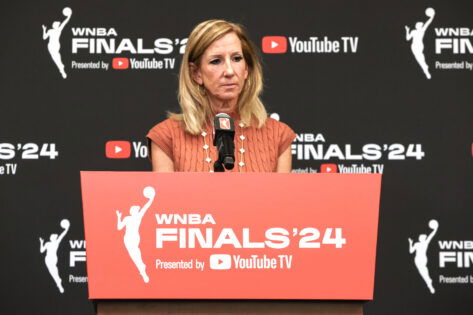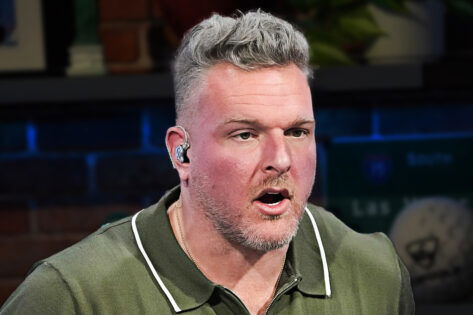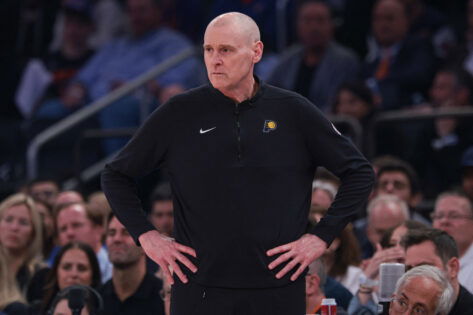WNBA is witnessing monetary success at a rate never seen before. The franchises have seen their value increase by almost 180% on average, with some franchises eclipsing that as well. And the backbone of this success, the players, are now demanding their fair share of income. Ahead of the 2025 season, the WNBPA president, Nneka Ogwumike, laid out some of the biggest concerns for the players in negotiations.
However, the clearly laid out demands made no progress, and the hope that both sides would be able to reach a fair conclusion is fading away like steam off the boiling water. Especially after receiving the WNBA’s first proposal in June. The draft turned out to be so disappointing that Satou Sabally described it as a “slap in the face.”
And Collier had already made it clear that they were not going to compromise this time. “No one wants a lockout, but I think we have to stand firm in what we think we deserve in this new CBA,” said Collier. Hence, the rejection. With only 116 days left for the current CBA to expire, let’s get into the knitty-gritties of this standoff…
What were the “unmatchable” demands that the WNBPA put forth?
According to a post that appeared on Kareem Copeland’s X (formerly Twitter) account, these were the demands laid down by the WNBPA:
First and foremost, a New Economic Model. The WNBPA demanded, “Transforming the current system, which imposes arbitrary and restrictive caps on the value and benefits players receive. By introducing an equity-based model that grows and evolves in step with the league’s business success.” And here’s where the league is playing majorly on the back foot, know about it later in the article.
Secondly, the Player Salaries: “Establishing clear distinctions between salary and bonuses. Ensuring players receive wages that properly reflect their value and contributions to the league’s growing business.” For instance, improving the disappointingly low All-Star bonuses. That forced Ogwumike to say that “there’s room for reconstruction, [All-Star bonuses] are another component of the salary and compensation in terms of performance bonuses. What we’re looking to do is not just have a percentage of a higher salary.”
Most important of all, Pregnancy and Family Planning Benefits: “Fair and accessible family planning support for all players, including retirement benefits that provide long-term security for their families.” Remember when Skylar Smith played the entire 2018 season while being pregnant? Yeah, it was because she had no support from the organization. Instead, she only received backlash. “People called me a quitter, said I gave up on my team, etc., etc. Not knowing I took two FULL months away from everything because of postpartum depression. With limited resources to help me be successful mentally/physically,” she tweeted. The WNBPA is trying hard to put an end to such practices.
Next comes a basic one, which is surprisingly absent in the current model. Minimum Professional Standards: “Implementing consistent minimum standards that align with other leading professional sports leagues, maintaining professional and safe environments across the league, including practice and game facilities, as well as travel accommodations.” This is a much-needed change to not repeat what Dearica Hamby went through. She had to file a lawsuit in U.S. District Court in Nevada against the league and her former team, the Las Vegas Aces, after being intimidated, discriminated against, and harassed. All over her, the handling of her pregnancy.
Finally, some much-deserved Retirement Benefits: “Expanding retirement benefits to provide greater financial security and health benefits to the Players for their life after basketball.” On paper, all of this sounds like the bare minimum, right? Especially for a league operating at an International level. However, the reality screams something else, and the WNBA hasn’t even come close to fulfilling half of these.
What were the key differences between the WNBPA’s proposal and the WNBA’s counteroffer?
As for WNBPA’s demands, in Ogwumike’s words, the players “want to have a growing portion of the revenue share,” she said. “We want this league to be exactly what it is today and more. So I’m hoping that something positive progressive yields from this meeting that we’ll have in Indy.” Here she’s referring to the All-Star weekend. In the middle of all the festivities, a crucial meeting is scheduled between the league and the WNBPA.
This discussion is taking place because, as Ogwumike’s words reflect, the union emphasized a revenue-sharing plan. They proposed that player salaries should rise in line with league profits. However, the league’s counterproposal suggested fixed salary cap numbers, which the union found unacceptable. Breanna Stewart was left with no choice but to describe the offer as “pretty polar opposite” of what the players had proposed.
This is sheer negligence on the league’s end. Moreover, to guess the tone of the discussion, just know that Breanna Stewart believes that it will be a ‘spicy’ meeting between players and the league. All thanks to the delayed responses and miscommunication between the two parties.
Why did the WNBPA feel disrespected by the WNBA’s negotiation process?
The league conveniently claimed that it received its first “official” proposal only in April. However, there are claims that the WNBPA submitted its first proposal the first week of February and another the last week of February. But just to delay the process and buy some time, the league allegedly rejected those. From there, the union submitted another one in April, to which the league responded in June.
“There’s this perception that the players don’t understand the business… Cathy has told me that to my face.”
The WNBA and its players union are far apart in CBA negotiations, and players are out to prove they know what they are fighting for.
— Front Office Sports (@FOS) July 8, 2025
Here’s where the sense of disrespect kicked in, and Ogwumike took it upon herself to clap back with a perfect proposal. Still, the delay and dismissal of earlier proposals eroded trust between both parties. To add fuel to that, “It’s been made clear that there’s this perception that the players don’t understand the business,” Ogwumike said. “Cathy has told me that to my face. I communicated that to the players and I said, ‘Let’s demonstrate that we do understand the business. Especially as we’re going back and forth in negotiations.”
Not just Ogwumike, but even other players like Breanna Stewart felt the disrespect in the form of ignorance. “Absolutely frustrated,” Stewart said of negotiations, via Owen Pence. “Anytime you go back-and-forth, you’re not expecting to hear that ‘yes’ on the first [proposal], but you’re expecting to have a conversation. They kind of just ignored everything we said.”
How does the WNBA’s financial growth conflict with the proposed salary structure?
The W is one of the fastest-growing professional leagues in the world. And most of that credit goes straight to its players. They have brought in an 11-year media rights deal valued at $2.2 billion with Disney, NBC, and Amazon. This partnership would have an effect next season worth an average of $200 million a year.
Moreover, the players are questioning that if it’s a loss-making league, then why are the new ownership groups in Cleveland, Detroit, and Philadelphia paying a record-breaking $250 million expansion fee? To top that off, the current CBA caps salary growth at 3% annually, which was set when financial prospects were less certain. Now that there are more consistent and greater income sources, the growth should be isomorphic as well.
Because of these rigid caps, the WNBA players currently earn only 9.3% of league revenue, far less than the ~50% shared in leagues like the NBA and NFL. Which is why the union wants uncapped salary growth tied to revenue increases to ensure fair compensation as the league prospers.
The post Why the WNBA Counter Proposal Was Rejected: Inside the Revenue Rift and Players’ Push for Fair Pay appeared first on EssentiallySports.



